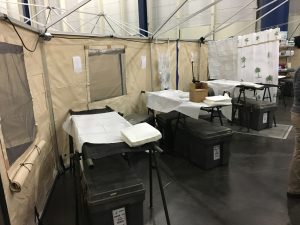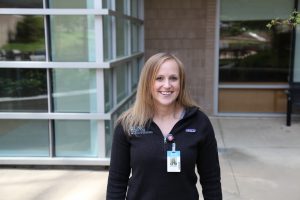It’s been six months since Hurricane Maria devastated Puerto Rico. Jennifer Sutherland Kelly, PharmD, a pharmacist in the emergency department at UNC Hospitals, arrived on the island shortly after the storm as part of a disaster medical assistance team – providing medical care and infrastructure assistance to those affected.

by Matt Englund, matthew.englund@unchealth.unc.edu, 984-974-1144
When Jennifer Sutherland Kelly arrived in Houston just after the worst of Hurricane Harvey last year, the thing that surprised her most was how routine the care she was delivering was.
Kelly is a critical care pharmacist and works in the emergency department at UNC Hospitals. She took a course in disaster medicine during pharmacy school and shortly thereafter was recruited by the Natural Disaster Medical System to join a disaster medical assistance team (DMAT). The Natural Disaster Medical System (NDMS) is administered by the U.S. Department of Health and Human Services.

“I’ve been with DMAT since 2010. During that time my team has responded to a several large scale events, including Hurricane Sandy, which happened during my residency training. What was different about 2017 was not just the scale of the events to which we responded but the fact that they were so close together.”
Members of a DMAT are intermittent federal employees, which means they are civilians until they are activated at which point team members become federalized employees. There are dozens of DMATs around the country. Teams rotate on-call responsibilities throughout the year.
“Really we can be called at any time, but we provide our availability ahead of time. So, for example, this year I was in a wedding when Hurricane Irma happened to make landfall. I told the NDMS months ago that I wasn’t available that particular week. So when I came home from Harvey, instead of them sending me right back out to Irma with the rest of my team I had a little off period.”
In cases like these, members of other teams will fill in to make sure the DMAT is fully staffed. And it is a large staff that needs to be prepared for any kind of deployment.
A 35-person roster on each team includes a commander, doctors, nurses, pharmacists, logistical specialists, and law enforcement. Teams might be called on to do anything from providing support to a local ED to creating a mobile ED in the community or medical shelter.
Along with personnel, teams usually travel with two 53-foot trucks loaded with any supplies they might need. And when Hurricane Harvey looked to be headed towards Texas late last year, Kelly’s team, which is based out of Atlanta, was activated.
“You start out on alert status, which means you need a go-bag packed because if something does happen you’ll be one of the first to go. When you move to activated status, you need to be prepared to leave in two hours – what that means is that I need to get home and grab my bag because NDMS is going to start sending out flight information.”
Kelly and her team waited out the storm in Dallas, travelling to Houston once the worst of the rains had passed and setting up a medical center in a shelter for those affected by the storm, which housed nearly 14,000 people when the team first arrived. She says part of their mission was to take some burden off of the local hospitals and to help with logistical challenges.
Most critically ill patients were sent to one of the local hospitals, many of which were still up and running, so the day to day work involved much more primary care – refilling prescriptions, preventing anything infectious from spreading.
Kelly recalls being surprised by the volume of psychiatric complaints she encountered.
“Some of these people have lost everything so there’s a lot of anxiety and depression, which is understandable. And if you are already struggling with issues like that and don’t have access to your meds, that can be a problem,” says Kelly. “With that many people all crowded into a shelter, things are tense, you can’t even really leave your spot. Then you imagine trying to do that as a single parent with three kids and you can see how rough that could be on your state of mind.”
But as crews worked to restore the city and floodwaters began to recede, the crowds in the shelter began to thin a little, and Kelly’s 14-day activation order came to an end.
It was only a few short weeks later that Kelly received new activation orders directing her to San Juan, Puerto Rico, to help with the aftermath of Hurricane Maria. Puerto Rico was a very different mission from Houston.
“There were already a few teams in there when we arrived who had gotten there ahead of the storm. What we didn’t have was any equipment or any way to communicate on the island. We had no idea if a hospital on the other side of the island had any power. As it turned out, no one had power.”
The first few days of the mission involved a lot of waiting. The chain of command is highly structured and teams need to wait for orders before they can mobilize. “The local government was aware we were there, but there weren’t reliable means of communication – we were using satellite phones for just about everything.”
After a few days of sleeping on cots in the San Juan Convention Center, the team was broken into several small medical task forces and sent to small communities around the island. Kelly was sent to a town in the mountains called Comerio, where she and others went door to door to check on people. The customs and border patrol agents travelling with them – DMATs are required to travel with federal law enforcement – helped to translate when necessary.
“It was a very unique mission. We had some army medics with us who had an ambulance and we just walked around the community, went to people’s homes and checked in on them. We had a few people who needed lacerations fixed, people who were having cardiac issues that we helped with, and we spread the word that we would be opening a clinic.”
They opened a clinic after a few days but the island’s infrastructure was still badly damaged, which presented a variety of obstacles to providing necessary care to the people of Comerio.
“Limited access to supplies and power on the island was a problem throughout the mission. We didn’t have a lot in terms of medicine, so I came up with a list of the most common medicines I thought we would need, went to a pharmacy and tracked them down where I could.”
Part of the issue was that because there were few places with power there was also very little access to the internet, which meant that pharmacies weren’t able to process insurance claims.
“There was one pharmacist that worked with us really closely. He would drive an hour every day to a town that had limited internet access, process everything and return home. He’d go back the next day with more. We bought some prescriptions from him – blood pressure meds, diabetes meds, things like that.”
One of the biggest challenges, according to Kelly, was access to insulin.
“There was none on the island and getting anything shipped in was very difficult – and once it was on the island, distributing it was also a problem. There was one urgent care near the town that had one vial of insulin. They couldn’t give it to anyone because they had to save it in case someone presented with a diabetic emergency.”
Kelly was in Puerto Rico for three weeks. Her activation orders were for longer (30 days) but after three major storms in as many weeks, the Natural Disaster Medical System began to pull people back early.
“Burnout was really high because almost everybody had been deployed for the other two hurricanes. I think once they started realizing that teams were burning out they started pulling people back a little early.”
Kelly admits that, for all her training and her extensive experience in emergency medicine here at UNC Hospitals, providing medical assistance after a disaster was still able to surprise her.
“When you go through disaster training, the standardized patients are a lot sicker, you are deciding whether you are going to black tag somebody, all these crazy triage things that just don’t happen that often in real situations. We tend to think of disaster medicine in acute terms, things like mass shootings, but a lot of the disaster medicine we dealt with was some of the downstream effects of people not having access to health care.”